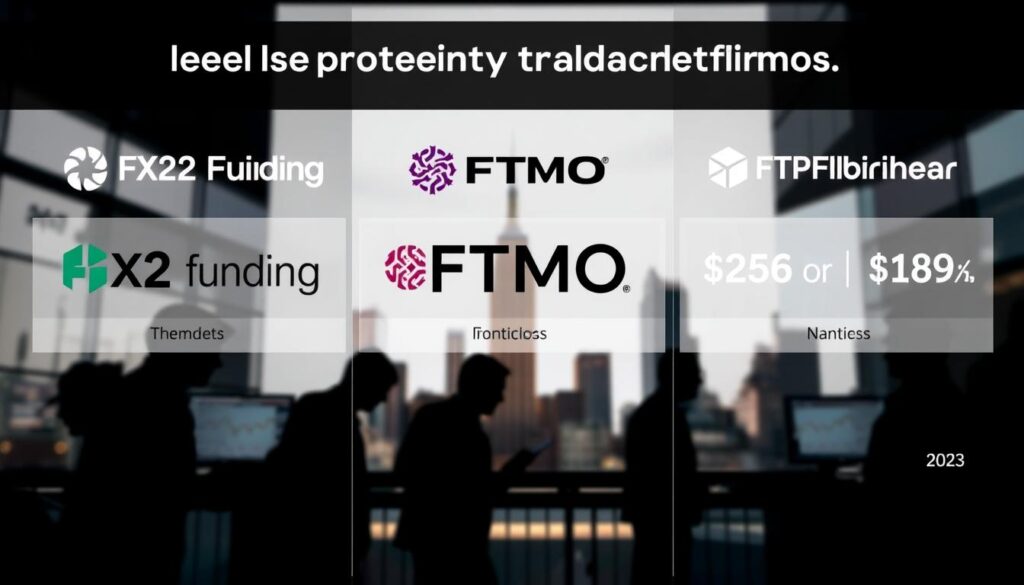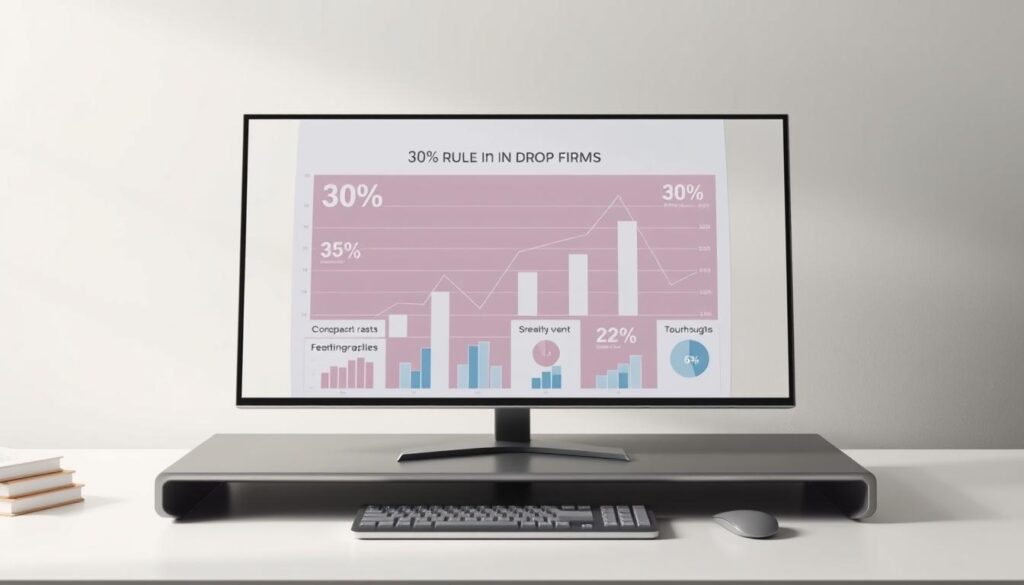Many individuals dream of a career in the financial markets but face a significant hurdle: a lack of personal funds. Proprietary trading, often called prop trading, offers a powerful solution. It involves firms using their own capital to trade various assets.
This model changes the game for skilled individuals. Instead of risking their own savings, talented people can access substantial funding from a prop firm. The company provides the capital, and the trader provides the skill.
Success in this field is based entirely on performance. It is not a shortcut to wealth but a professional path built on discipline and consistency. The firm and the trader share a common goal: generating profits from market movements.
This comprehensive guide will walk you through the entire landscape. It covers everything from fundamental concepts to evaluating top firms. The focus shifts from how much money you have to how well you can trade.
Readers will learn about evaluation processes, risk management techniques, and the technology platforms used. This resource is designed to be the definitive starting point for anyone serious about building a career with a proprietary trading firm.
Understanding Prop Trading: A Beginner’s Overview
Unlike traditional brokerage models, proprietary firms focus on direct market participation using internal capital. This approach differs fundamentally from retail activities where individuals risk personal funds. The proprietary trading model represents a complete shift in financial strategy.
In this arrangement, the company provides the investment funds while skilled individuals contribute their expertise. This creates a powerful partnership where both parties benefit from successful outcomes. The firm’s resources and the trader’s abilities combine for optimal performance.
These operations involve diverse financial instruments across global exchanges. Stocks, bonds, currencies, and derivatives all form part of the trading portfolio. Specialized desks utilize advanced technology that would be costly for individual investors.
The risk-reward structure places market exposure on the company since it uses its own money. However, firms also share in the profits generated by their funded professionals. This creates alignment between institutional goals and individual performance.
Proprietary trading emphasizes short-term speculative strategies rather than long-term investments. Techniques like arbitrage and volatility analysis drive decision-making. The entire process values consistent performance and disciplined risk management above initial capital.
This field offers a legitimate career path for talented individuals without significant personal funds. Success depends on developing reliable strategies and maintaining emotional control. The proprietary approach transforms market skill into professional opportunity.
How Prop Trading Firms Operate

The core of a proprietary firm’s operation is a symbiotic relationship between financial backing and individual skill. These companies provide the capital, technology, and market infrastructure. In return, talented individuals contribute their strategic expertise and disciplined execution.
This model creates a powerful alignment of interests. A prop firm’s revenue comes from a share of the profits generated. They only succeed when their traders do, making trader success the firm’s primary goal.
This contrasts sharply with a traditional brokerage. A standard broker offers a platform for people to trade their own money. The broker earns fees on transactions, regardless of the client’s profitability.
Proprietary firms absorb the financial risk of market losses. After passing a skills evaluation, a trader uses the company’s capital. This removes the burden of personal financial risk beyond a small initial assessment fee.
The evaluation process is a critical step. It ensures only those with proven skill and risk management receive funding. This vetting protects the firm’s capital and identifies serious candidates.
Ongoing support is a key feature. Firms often provide educational resources and community access. This creates a genuine partnership where both parties benefit from consistent, profitable performance.
Navigating Evaluation Processes and Trading Challenges

The evaluation process serves as the critical gateway for aspiring professionals seeking funded opportunities. This simulated environment tests abilities under realistic market conditions. Candidates must demonstrate consistent profitability while following strict risk management protocols.
Understanding Evaluation Phases and Profit Targets
Most proprietary firms structure their assessment with multiple stages. These typically include a demo phase and sometimes a verification round. Each step measures the candidate’s ability to meet specific profit objectives.
The profit target represents a crucial benchmark in this process. It proves the viability of a trader’s strategy. Success requires generating consistent returns while managing risk effectively.
Managing Drawdown Limits and Trading Rules
Daily loss limits force disciplined behavior when markets move against positions. This prevents emotional revenge trading that can destroy accounts. Professionals learn to step away and reassess their approach.
Overall maximum drawdown teaches the essential skill of capital preservation. This constraint is often more valued than profit generation. Proper position sizing ensures no single trade violates these critical boundaries.
Firms commonly restrict certain strategies to ensure sustainable approaches. Understanding these rules during evaluation creates habits that serve throughout a career. Internalizing these constraints builds the discipline needed for long-term success.
Risk Management and Trading Discipline

Market professionals understand that preserving capital is more crucial than chasing profits. This mindset forms the bedrock of sustainable performance in volatile markets. Proper risk control separates consistent performers from those who experience dramatic swings.
Implementing Stop-Loss and Position Sizing Techniques
Effective risk management begins with technical safeguards. Stop-loss orders automatically exit positions when prices move against predictions. This prevents small losses from becoming catastrophic.
Position sizing determines how much capital to risk on each opportunity. Professionals rarely expose more than 1-2% of their account to a single trade. This approach ensures survival during inevitable losing streaks.
Firms often provide tools to help implement these techniques. Automated calculators suggest appropriate position sizes based on account balance. Strict daily loss limits protect both the individual and the company’s capital.
Building Emotional Resilience for Consistent Trading
Psychological strength proves equally important as technical skill. Emotional control means sticking to a plan during both winning and losing periods. Overconfidence after success can be as dangerous as panic during downturns.
Common pitfalls include revenge trading after losses and impulsive entries driven by fear of missing out. Maintaining a detailed journal helps identify these emotional patterns. Structured routines create stability when markets become chaotic.
Many companies offer resources specifically focused on trading psychology. Mentorship programs help develop the mental discipline required for long-term success. This support system builds the resilience needed to execute strategies consistently.
Leveraging Educational Resources and Mentorship

Access to quality learning materials separates exceptional trading careers from average ones. Proprietary firms recognize this and often build comprehensive educational ecosystems. These systems provide crucial support for skill development.
Structured Learning for New Traders
Many firms offer structured courses covering essential topics. These resources include webinars on market analysis and risk management. The educational content helps new traders build solid foundations.
Structured evaluations serve as practical learning opportunities. They teach discipline and consistency through real market simulations. This hands-on approach accelerates skill development for aspiring professionals.
Community Support and Mentorship Programs
Active trading communities provide daily support and shared learning. Traders can discuss strategies and market observations together. This collaborative environment fosters rapid growth.
Mentorship programs pair beginners with experienced funded professionals. Personalized feedback on trading plans and performance analysis becomes available. Learning from others’ experiences helps avoid common mistakes.
The community aspect provides emotional encouragement during challenging periods. Lasting professional relationships often form within these networks. This support system maintains motivation through inevitable market fluctuations.
Access to Capital: Scaling Your Trading Career

Scaling trading operations requires access to substantial financial resources beyond individual means. This represents the core advantage of the proprietary model for skilled individuals.
The arrangement removes personal financial risk while enabling participation in larger market movements. Professionals can focus entirely on strategy execution rather than capital preservation.
Increasing Profit Splits and Funded Account Growth
Profit sharing structures create powerful incentives for consistent performance. Many firms begin with splits favoring the individual by 50-80%. This percentage often increases as traders demonstrate sustained profitability.
Performance milestones trigger improved terms. Achieving consecutive profitable months or specific profit thresholds can elevate splits to 90% or even 100%. The system rewards skill development with greater income potential.
Account scaling programs complement profit share improvements. Starting accounts typically range from $25,000 to $50,000. Consistent performance can lead to growth exceeding $400,000 in managed capital.
This combination of larger accounts and better splits creates exponential earning potential. Growth becomes accessible based purely on demonstrated ability rather than additional personal investment.
Toolkits and Platforms: Navigating Technology in Prop Trading
Technology serves as the backbone of modern proprietary trading operations. These firms provide powerful software that gives individuals a significant edge. This access to institutional-grade tools is a primary benefit of the model.
Platforms like FX2 Funding’s MT5 create a professional environment for execution. They offer sophisticated features for analysis that would be costly for an individual. The learning curve varies, but user-friendly interfaces help new users adapt quickly.
Utilizing Advanced Trading Platforms
An advanced platform is more than just a place to execute orders. It integrates real-time data feeds, premium charting packages, and risk management features. Clear analytics help traders spot mistakes and refine their way of working.
Some firms offer high leverage options, which require careful management. The right platform provides the stability and speed needed for precise entries and exits. It is a critical tool for managing a funded account effectively.
Leveraging Analytical Tools for Market Precision
Beyond the core platform, specialized tools enhance decision-making. Premium charting software includes Fibonacci retracements and volume profile analysis. Real-time news feeds help anticipate market-moving events.
Backtesting tools allow strategies to be validated against historical data. Market scanners automatically identify potential setups based on custom criteria. Analytics dashboards track performance metrics, enabling continuous improvement.
This technological ecosystem provides a comprehensive way to approach the market. It supports disciplined proprietary trading and helps traders scale their skills with the firm‘s capital.
Comparing Top Prop Firms: FX2 Funding, FTMO, and More

Choosing the right proprietary trading company requires careful comparison of their unique features and funding structures. Each firm offers distinct advantages tailored to different trading styles and experience levels.
Firm Features and Flexible Funding Models
Funding approaches vary significantly across the industry. Some companies provide instant funding after a single evaluation phase. Others require multi-step verification processes before allocating capital.
Profit split structures represent another key differentiator. They range from standard 50-50 arrangements to more favorable 80-20 splits. Exceptional performers can even achieve 100% profit retention after reaching specific milestones.
Evaluation costs also differ substantially between companies. Challenges typically range from $100-200, though some firms offer free trial periods. Account sizes start from $10,000 and can exceed $200,000 depending on the selected program.
Traders should carefully consider supported markets when selecting a firm. Options include forex, stocks, indices, commodities, and cryptocurrencies. Scaling programs differ in speed and maximum account growth potential.
Payout frequency and reliability remain critical factors for professionals. Top firms offer bi-weekly or on-demand withdrawals with consistent processing. This ensures timely access to earned profits.
Prop Trading for Beginners: Strategies, Tips, and Pitfalls
The journey from novice to funded professional involves mastering specific strategies while avoiding critical errors. This phase requires patience and dedication to develop the necessary skills.
Success typically takes several months of consistent effort. Beginners should set realistic expectations about the time required.
Developing a Consistent Trading Strategy
A reliable approach forms the foundation of sustainable performance. Traders must focus on discipline and emotional control.
The process involves testing methods through demo accounts first. This allows refinement without financial risk.
Consistency proves more valuable than occasional large wins. Professionals prioritize steady growth over quick profits.
Avoiding Common Mistakes in Early Trading
Many beginners fall into predictable traps that hinder progress. Recognizing these patterns helps prevent costly errors.
Over-trading represents a frequent challenge for new entrants. Taking too many positions increases costs and exposure.
Revenge trading after losses often leads to account destruction. Emotional decisions violate sound risk management principles.
Ignoring firm rules, even with strong conviction, can cause evaluation failure. Each trade must respect established boundaries.
Strategy-hopping prevents developing true expertise in any approach. Stick with one method long enough to master it.
Final Insights on Launching Your Prop Trading Career
The path to becoming a funded professional demands more than just market knowledge—it requires unwavering discipline and emotional control. This career model transforms skilled individuals into business owners managing company capital.
Ideal candidates demonstrate resilience under pressure and commitment to continuous learning. They treat each trading day as an opportunity for growth, not just income generation.
Success comes from consistent execution of a proven strategy while adhering to risk management rules. The evaluation process serves as valuable preparation for real market challenges.
New traders should leverage educational resources and community support during their development. With realistic expectations and a solid plan, the proprietary model offers genuine career advancement without personal financial risk.

